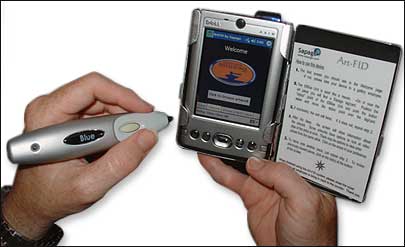Apr 28, 2005Granite State MetalWorks, an art gallery and studio in Littleton, N.H., has installed RFID tags next to artwork to help visitors and potential customers find out more about the individual pieces they may be interested in purchasing without having to talk with staff.
"People like to look and be left alone. They come in and look around but are shy and don't want to ask questions. With this system they can pick up the PDA, walk around and get a lot of information," says Michael Conroy, cofounder and owner of the Granite State MetalWorks.
The gallery is using Sapago's Art-FID system, which combines RFID tags and readers with PDAs and wireless communications. Since early April, gallery visitors can borrow one of three Dell Axiom PDAs and a pen-size Cathexis Innovation IDBlue RFID reader. As they walk around the gallery, the visitors can use the IDBlue to read the unique ID number of a Texas Instruments Tag-it 13.56 MHz RFID tag placed beside certain works of art. The reader transmits the tag's number over a Bluetooth wireless connection to the PDA, where the unique tag number correlates with information on the artwork stored in a database. From the screen of the PDA, visitors read descriptions of the artwork and its artist, and learn its price.
Besides using the IDBlue for Art-FID systems at art galleries and auction houses, Sapago says it will use the RFID reader for other personal-shopping products that it is developing for different retail settings.
Sapago says it launched Art-FID first because galleries have a low rate of converting visitors into customers for the reason that visitors can feel uncomfortable with asking questions about the works available. "Art galleries are the most extreme example of retailing, where very few customers want to ask a salesperson. No one wants to show interest in a piece only to be told it cost $5 million and that they can't afford," says Michael Zammuto, president of Sapago, which is based in Delray Beach, Fla. According to the firm, less than 1 percent of people who walk into a gallery buy something—the worst rate in retailing.
Sapago explains that it chose to use RFID tags instead of bar code labels to identify artwork because RFID tags are easier for consumers to scan. The system is priced at around $1,000 per Art-FID device, which includes the PDA, RFID reader and software.
So far, Granite State MetalWorks has installed just 17 tags, but during the next few months, it plans to expand the number of installed tags to 173 tags to cover all the pieces in its 1,500-square-foot space.
The gallery already had electronic data on its artwork stored on PCs at the gallery because customers often want staff to e-mail details about a piece to the customers' friends and family members to help them decide on a purchase. When Granite State MetalWorks deployed the Art-FID system, it simply transferred the data to the PDAs.
By the end of May, Granite State MetalWorks' Art-FID system will allow visitors to e-mail pictures and a summary of the artwork directly from the PDA. However, the gallery will have to deploy a Wi-Fi network to enable the connection between the PDA and the Internet.


